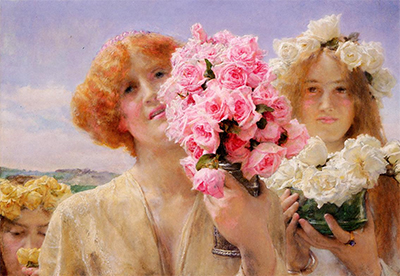Summer Offering is an oil on canvas portrait by Lawrence Alma-Tadema painted in 1911.
The portrait bears the hallmarks of romanticism in its representation of three young girls dressed in flowing classical style gowns and presenting an offering of roses against a vibrant Mediterranean background.
Not only are the girls bearing roses but they are also adorned with roses of three different colours. Alma-Tadema was renowned for his highly realistic and detailed depictions of flowers and other finely textured objects.
Summer Offering showcases the painter's talent for recreating these highly detailed elements.
The subject matter too is typical of Alma-Tadema who favoured classical scenes and utilised unusual composition, as in Summer Offering, where one of the girls is abruptly cut out at the edge of the painting.
Having been introduced to most of the Pre-Raphaelite painters by the time he produced Summer Offering, their influence can be seen in this work in terms of the brightness of the colours and lightness of the brush strokes which Alma-Tadema adopted for this and many of his later works.
Born Lourens Alma Tadema in Dronrijp in the Netherlands, Sir Lawrence Alma-Tadema as he would later be known, became one of the most successful painters of the Victorian period.
His elaborately detailed paintings of beautiful ladies and gentlemen set against classical backgrounds were hugely popular during his lifetime and he became one of the most financially successful painters of the period.
Having made England his adopted home, Lawrence Alma-Tadema was awarded a knighthood from Queen Victoria in 1899, becoming one of only eight artists from Europe to receive the title.
However, during the final years of his life, artistic movements such as Post-Impressionism, Cubism, and Futurism were beginning to emerge and Alma-Tadema's work was seen as increasingly irrelevant with John Ruskin even proclaiming him to be the worst painter of the 19th century.
After his death in 1912, Alma-Tadema's work was largely ignored and drifted into obscurity. His paintings were not exhibited again until 1962. Today, by contrast, Alma-Tadema is recognised as one of the finest 19th-century painters of classical subjects with some of his paintings selling for tens of millions of dollars.




